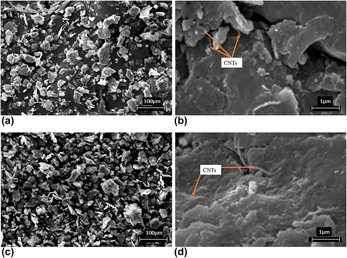Article contents
Effect of carbon nanotube content and double-pressing double-sintering method on the tensile strength and bending strength behavior of carbon nanotube-reinforced aluminum composites
Published online by Cambridge University Press: 08 December 2016
Abstract

In this research work, planetary ball mill has been used to disperse carbon nanotubes (CNTs) in Al powders. Al-CNT nanocomposite samples have been produced using double pressing double sintering (DPDS) method. The effects of CNTs weight percent and secondary pressing and sintering on the hardness, tensile, and bending strength of Al-CNTs nanocomposites were investigated. Enhancements of about 98% in hardness, 40% in tensile strength, and 20% in bending strength of Al-CNTs nanocomposites were observed as compared with pure Al samples. Using DPDS technique increments of 2.4–16.14% in density has been obtained as compared with the nanocomposites produced by conventional sintering method. The composites were studied by scanning electron microscope and differential thermal analysis. The X-ray diffraction (XRD) was used to identify various phases if present in Al-CNTs nanocomposites.
- Type
- Articles
- Information
- Copyright
- Copyright © Materials Research Society 2016
References
REFERENCES
- 5
- Cited by





